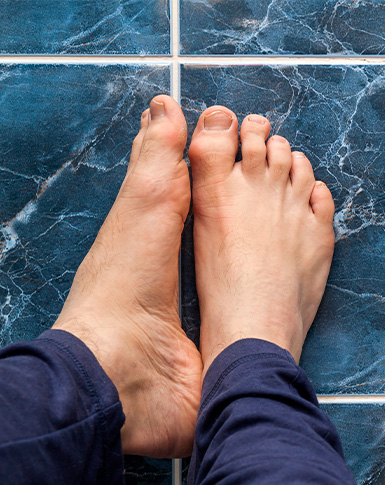
What Is Athlete’s Foot?
Athlete’s foot is a common fungal infection that affects the skin and toenails on the feet. Also known as tinea pedis (skin) or onychomycosis (nails), this skin condition is contagious and is most commonly seen in athletes. While the condition itself is not serious, it can be uncomfortable and troublesome if not diagnosed and treated. Our team of dermatologists at Snyder Dermatology in Austin, TX, work with people daily who have this troubling condition, which keeps them from being the best they can be at work or home.
What Causes Athlete’s Foot?
Athlete’s foot occurs when the fungus grows on the feet, which can be anywhere on the foot, including the top, underside, heel, or toes. Anyone can get it, but it is often spread in gym locker rooms, swimming pools, showers, or other areas where the infected person walks barefoot with others. Wearing tight-fitting shoes, having sweaty feet, and minor skin injuries on the feet, all of which can occur among athletes, are common causes for the fungus developing.

Symptoms of Athlete’s Foot
If the foot has red blotchy areas, is itchy, or has moist, flaking skin, then a possible infection may exist. Our dermatologists can often diagnose athlete’s foot based on these types of symptoms alone. In some cases, a skin test and or even a biopsy will be taken in case there is concern for a more serious issue. In our office, we perform what is known as a potassium hydroxide test (KOH) exam. During this test, a small area of the infected skin is scraped off and placed in a potassium hydroxide solution. KOH destroys the normal skin cells of the scraping and leaves the hyphae of the fungus untouched, which allows us to easily diagnose the infection under a microscope. If athlete’s foot does come back as a confirmed diagnosis, proper treatment will then be prescribed along with behavior modification.
CONTACT US
Have questions or want to schedule an appointment? Contact us today to speak with a member of the Snyder Dermatology team. We’re here to address your concerns with compassionate and effective care.
CONTACT

Board-Certified Dermatologists
MEET OUR DOCTORS
Snyder Dermatology is the premier practice for medical and cosmetic dermatology in Austin, TX. Centrally located, our dynamic team of board certified dermatologists focus on providing patients with the most advanced medical care and treatment options. Our practice is distinguished by our compassion, our desire to fully understand our patients’ needs, and our commitment to being good stewards in the communities where we live and work.
How to Treat Athlete’s Foot
Many men and women who get athlete’s foot often times understand that they have a fungal infection and simply use over-the-counter (OTC) topical antifungal medications, which, in many cases, can be effective. If these medications do not treat the fungus, and the infection persists or gets worse, then a visit to our dermatology clinic is usually recommended. Numerous prescription medications can help treat the infection, including topical, prescription-strength antifungals, and oral antifungal medications such as itraconazole, fluconazole, or terbinafine. At times, oral antibiotics are combined in the treatment to help with secondarily infected blisters, which reduce inflammation and prevent additional blisters from developing. It’s important that patients adhere to an at-home regime, including keeping the feet dry and soaking the feet in salt water or diluted vinegar to help accelerate the healing and drying up of the blisters.
Schedule a Consultation
Athlete’s foot can be severe or mild. It can be a condition that comes and goes and worsens over time. Diagnosing the fungus and treating it, and then understanding the right protocol to take, will help treat this infection. If you believe you have a fungal infection on your feet, including the heel, sides, top and/or bottom, or between your toes and nails, please call Snyder Dermatology and make your appointment so that relief can be found.




